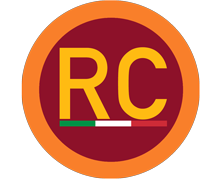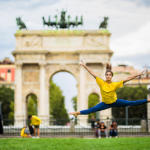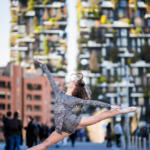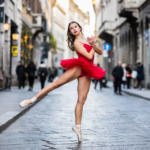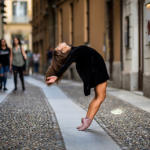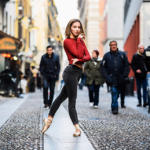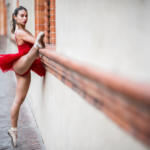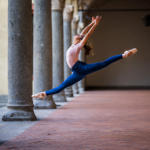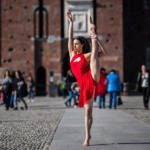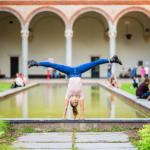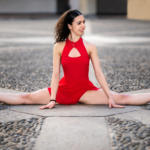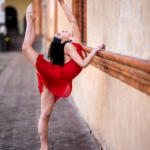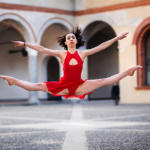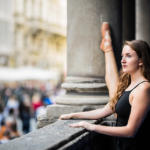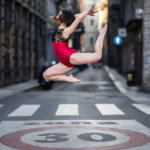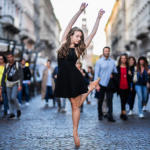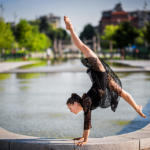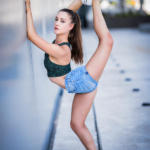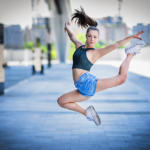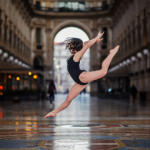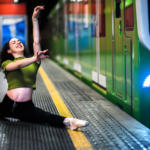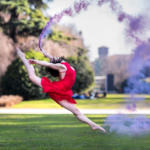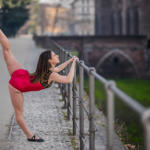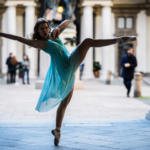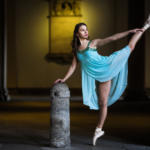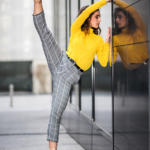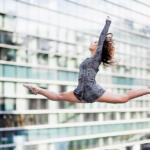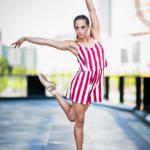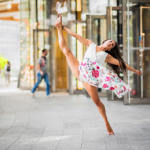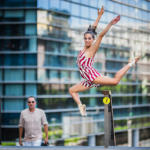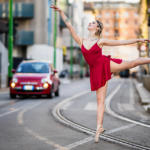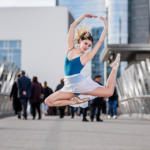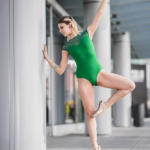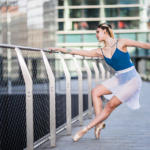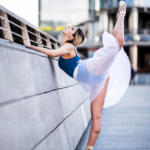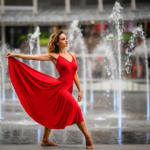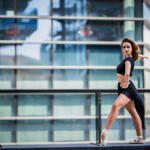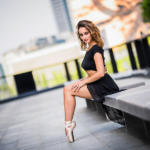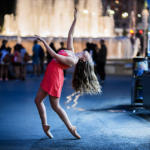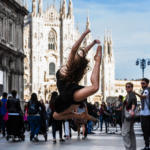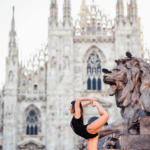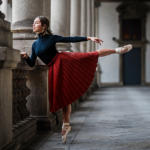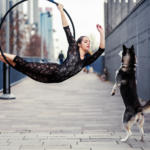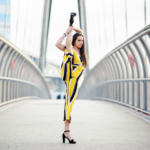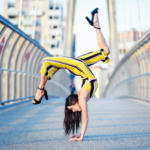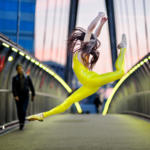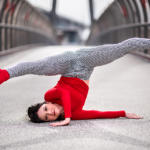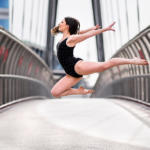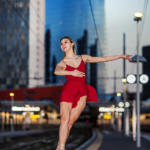 Milan is one of the world capitals of fashion and design, it is an avant-garde city, very active from an economic and cultural point of view.
Milan is one of the world capitals of fashion and design, it is an avant-garde city, very active from an economic and cultural point of view.
The Gothic cathedral (il Duomo) is one of its symbols, but also the convent of Santa Maria delle Grazie, which houses the fresco “The Last Supper” (L’Ultima Cena) by Leonardo da Vinci, testify to the city’s artistic and cultural heritage with many hidden treasures among poetic foreshortenings, liberty style buildings and small architectural pearls that range from the Gothic to the Romanesque style, scattered in its beautiful and very ancient historical center.
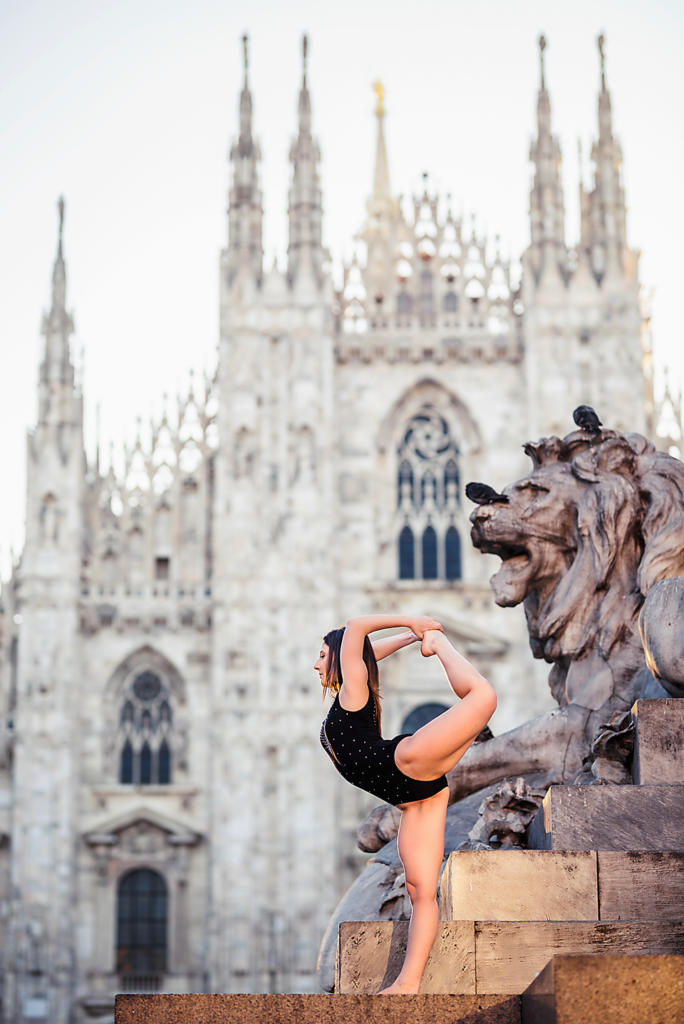 The Duomo cathedral naturally could not be missing in our photographs, but it was really difficult to be able to photograph it in its entirety with the dancer in the foreground. Being very large, the only way is to get away a lot, but with all the people that pass the company all the time is really hard. Fortunately, there are many well-known ideas for our photo sessions, and one of my favorites is definitely the Pinacoteca di Brera, a museum of international stature, the national gallery of ancient and modern art officially established in 1809.
The Duomo cathedral naturally could not be missing in our photographs, but it was really difficult to be able to photograph it in its entirety with the dancer in the foreground. Being very large, the only way is to get away a lot, but with all the people that pass the company all the time is really hard. Fortunately, there are many well-known ideas for our photo sessions, and one of my favorites is definitely the Pinacoteca di Brera, a museum of international stature, the national gallery of ancient and modern art officially established in 1809.
The Brera district is one of the most characteristic and romantic areas of the city, the streets are almost all pedestrian and allow themselves to pleasant walks between restaurants and shops, but also and above all for us, an ideal setting for dance poses.
 From the alleys of Brera it is possible to reach in a short time the Castello Sforzesco, a fortification located in the historical center of the city, built in the XV century by Francesco Sforza, Duke of Milan, on the remains of a previous medieval fortification dating back to the XIV century and known as Castello di Porta Giovia (Wikipedia source). The courtyards of the castle are really beautiful as is the Sempione park, which surrounds it and is the real green lung of Milan.
From the alleys of Brera it is possible to reach in a short time the Castello Sforzesco, a fortification located in the historical center of the city, built in the XV century by Francesco Sforza, Duke of Milan, on the remains of a previous medieval fortification dating back to the XIV century and known as Castello di Porta Giovia (Wikipedia source). The courtyards of the castle are really beautiful as is the Sempione park, which surrounds it and is the real green lung of Milan.
 Moving with the subway you can easily pass in a few minutes, from the antiquities of the Duomo and the Sforzesco castle towards the absolute modernity square of Piazza Gae Aulenti, awarded by the Landscape Institute as one of the most beautiful squares in the world, in terms of innovation and environmental protection. The square that many have called the “square of the future“, was in fact conceived as a meeting and social point for citizens among the luminous fountains and the difference in height of six meters above the city, an ideal place for where to enjoy a well-deserved rest with a view of the Milanese skyline, while also admiring the famous Milanese skyscraper of the Vertical Forest.
Moving with the subway you can easily pass in a few minutes, from the antiquities of the Duomo and the Sforzesco castle towards the absolute modernity square of Piazza Gae Aulenti, awarded by the Landscape Institute as one of the most beautiful squares in the world, in terms of innovation and environmental protection. The square that many have called the “square of the future“, was in fact conceived as a meeting and social point for citizens among the luminous fountains and the difference in height of six meters above the city, an ideal place for where to enjoy a well-deserved rest with a view of the Milanese skyline, while also admiring the famous Milanese skyscraper of the Vertical Forest.
 With a similar style we can also find the CityLife district, a redevelopment project of the former Fair area (ex Fiera), which was left following the transfer of the exhibition activities to the new pole of Rho-Pero, where possible go shopping at the shopping center of the same name rather than stroll through the beautiful adjacent park. We tried to create a different perspective for these wonders, of course we were not allowed to take pictures anywhere, but together with the talented models we did our best to represent in our own way, that is through dance, the city of Milan.
With a similar style we can also find the CityLife district, a redevelopment project of the former Fair area (ex Fiera), which was left following the transfer of the exhibition activities to the new pole of Rho-Pero, where possible go shopping at the shopping center of the same name rather than stroll through the beautiful adjacent park. We tried to create a different perspective for these wonders, of course we were not allowed to take pictures anywhere, but together with the talented models we did our best to represent in our own way, that is through dance, the city of Milan.
My special thanks goes to all of them, beautiful, very good, an honor to have worked with you (in alphabetical order):
• Bianca Arama
• Cristina Matarozzo
• Eleni Quartana
• Eleonora Cancelliere
• Erika Ravot
• Federica De Stefanis
• Gaia Merulla
• Giorgia Faoro
• Marcella Sammartino
• Martina De Luca
• Silvia Paone
Giovanni Malandrino is a freelance professional photographer, specialized in urban dance photography. Based in Milan and Novara, for his photographs he likes to move to different cities to combine the elegance of the poses in the ballet with the wonders of our beautiful Italy.
Dance is the creation of a sculpture that is visible only for a moment (cited by Erol Ozan)
If I had to choose a sentence to represent my photographs I would have no doubt starting from this quote. This is the starting point because once the perfect moment has been created, photography can make it eternal and make it live every time we observe it.
And these moments have to be shared because the art can not remain closed in a room or a computer, but must be free to be observed by anyone who can appreciate the elegance of the shapes and colors.
Photography is a great love for me, born about twenty years ago and as many fans I started participating in numerous courses and workshops in particular of portrait, fashion, fashion.
Before finding my way, I collaborated in the creation of photographic services in the field of fashion, but I felt that something was missing, in particular a blank sheet where you could create freely without constraints and predefined schemes and then lightning stroke, when photographing the my first dance essay I felt the possibility of creating art in movement with every shot. And where to better highlight the elegance of the poses if not putting them in contrast with the road, with normal everyday life?
This is how my personal way of creating art was born, which I hope will inspire in you a great part of the emotions that I feel every time I shoot a single photograph, a bit like a painter who paints his canvas.
A special thanks to my family who has always supported me in all my bizarre photographic adventures and all the talented dancers who have worked with me and with whom we created a wonderful friendship that goes far beyond the work. In fact, looking at the photographs you would not say, but a photo session in urban dance is very challenging, often in difficult weather conditions, walking for hours in search of the right background combined with the best light, in short, almost always ends exhausted, even if happy with the result.
